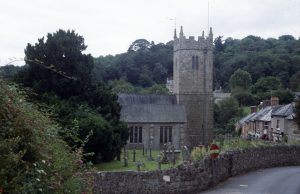 The prologue of my second Lady Apollonia West Country Mystery, Plague of a Green Man, is set in Dartmoor in 1380. This is a truly ancient region in Devon, England, between the medieval city of Exeter and the modern city of Plymouth. The story begins with my character, the pardoner, Brandon Landow, sent on a mission to Grimspound who becomes engulfed in a famous Dartmoor fog. After a terrifying struggle to emerge from the blinding fog, he finds safety at last in the medieval church, shown above, in the village of Lustleigh.
The prologue of my second Lady Apollonia West Country Mystery, Plague of a Green Man, is set in Dartmoor in 1380. This is a truly ancient region in Devon, England, between the medieval city of Exeter and the modern city of Plymouth. The story begins with my character, the pardoner, Brandon Landow, sent on a mission to Grimspound who becomes engulfed in a famous Dartmoor fog. After a terrifying struggle to emerge from the blinding fog, he finds safety at last in the medieval church, shown above, in the village of Lustleigh.
Dartmoor today covers an area of around 240 square mile inhabited rather sparsely by about 33,000 people. It is the oldest of England’s national parks and consists of much open-range moorland in its centre. This moorland is full of exposed granite and other types of stone, often covered with peat bogs which absorb large amounts of rainfall. Dartmoor granite has been quarried over the centuries for buildings, and basalt from Dartmoor is used in the vault of Exeter Cathedral’
The sources of at least a half dozen rivers are found in Dartmoor including the East Dart and West Dart which merge at Dartmeet to form the Dart River from which the moor gets its name. Many of the valleys through which these rivers descend in all directions towards the sea are heavily wooded in sharp contrast to the barren landscape atop the moor. This known fact was used by Brandon Landow to achieve his orientation in the fog by following a stream until he could reach some sort of habitation and find rescue in Lustleigh.
The centre of Dartmoor is only ten miles from Exeter, but is so remote that it provided the setting for Arthur Conan-Doyle’s Hound of the Baskervilles. My husband and I used Dartmoor to escape from civilisation during the years we lived in Exeter. We thoroughly enjoyed hiking the desolate moor but also visiting medieval churches in the moorland villages and towns. Dartmoor is dotted with granite outcroppings called tors. Climbing these tors afforded wonderful views of the surrounding countryside.
Several times when we were on the moor, we experienced being engulfed in blinding fog, as Brandon Landow did in my story. When hiking, we always carried a compass because all landmarks could be quickly obliterated. The bogs were always a hazard as well because one’s footing could begin to sink in a bog to the point where one became fearful of being swallowed. We carefully watched where horses and livestock walked on the open-rangeland. They seemed to know where the footing was safe and secure.